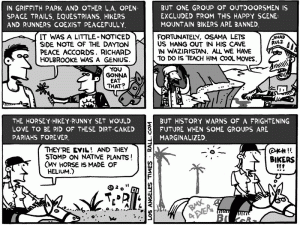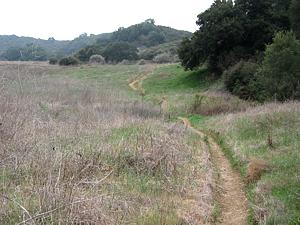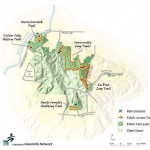A comprehensive update of the city’s bicycle plan still gives precedence to hikers and equestrians. The issue reflects animosity born of anecdotal reports of unpleasant trail encounters.
Not long after mountain bikers spun onto the scene in California in the early 1980s, dustups erupted with hikers and equestrians who found dodging hell-bent-for-leather cyclists on narrow trails unpleasant and at times dangerous.
![58555482[1]](http://corbamtb.com/news/wp-content/uploads/2011/01/585554821-150x150.jpg)
Don Wildman, founder of Bally's Total Fitness, peddles his mountain bike into the hills near his Malibu home in 2009. A comprehensive update of the city of Los Angeles' 2010 bicycle plan was approved in December by the Planning Commission, but the issue of bikes sharing the trails with hikers was sidestepped. (Al Seib / Los Angeles Times)
Heeding those complaints, the city of Los Angeles prohibited bicycling of any kind on trails designated for hikers and equestrians. Despite mountain bikers’ efforts over the years to win access to dirt trails in Griffith Park and other open spaces, the ban has remained in effect — except for Mandeville Canyon Park, where cyclists do share trails.
Other major cities such as Philadelphia, New York and Phoenix have figured out how to let hikers, equestrians and cyclists coexist on the dirt. But Los Angeles officials and planners have all but sidestepped action on the issue in a comprehensive update of the city’s 2010 bicycle plan that was approved in December by the Planning Commission.
The update will be reviewed by Mayor Antonio Villaraigosa‘s office before City Council consideration early this year. It calls on the city’s Department of Recreation and Parks to study best practices in other locales and collect data. That marks some backpedaling from earlier bicycle plans that recommended pilot programs for mountain bikes on city trails. No such programs were implemented.
“There is nothing in the new proposed bicycle plan that would expand mountain bikes’ usage on city parkland or on mountain trails,” said Ken Bernstein of the Department of City Planning.
Bernstein, a principal planner, said the mountain biking debate remains a tiny piece of the overall bicycle strategy, which calls for new bikeway networks encompassing more than 1,680 miles, a jump from the current 339 miles. The plan also commits the city to implementing 200 miles of bicycle facilities every five years.
“We think the bigger story is the fact that the Planning Commission adopted a very far-reaching and, we think, state-of-the-art new bicycle plan for the city that has tremendous support,” he said. “Overall, the plan makes very bold statements … including the goal of making every street in Los Angeles a safe place to ride a bike.”

Ted Rall / For the Times
The unwillingness of many hikers and equestrians to budge on the bike issue reflects animosity born of anecdotal reports of trail encounters that have injured hikers and horses. In 2005, a horse trying to dodge three mountain bikers on a Santa Barbara trail fell down a canyon, broke its back and was euthanized. In September 2009, a 74-year-old hiker on the Betty B. Dearing trail in Fryman Canyon reported that a speeding mountain biker clipped her on the shoulder and sent her sprawling on the gravelly path.
“It’s been a more serious issue in California than elsewhere,” said Stuart Macdonald, editor of American Trails magazine and its website. “People take more extreme positions, and they seem to not have this kind of culture of ‘People have a right to be there, and we need to figure out how to solve the problem.'”
In the months before city planners finished the draft bicycle plan, a consultant tried unsuccessfully to find middle ground between equestrian and mountain bike representatives.
Many hikers and equestrians assert that mountain biking poses two main problems: danger to cyclists and others on the trail and the potential for trail damage.
“My feeling as a member of the Griffith J. Griffith Trust [which distributes money for Griffith Park improvements] is that mountain bikes do not mix on the trail with hikers, horse people and runners,” said Clare Darden, the hiker who was knocked down on the Dearing trail. “In parks in urban settings where people are on foot or on a horse and somebody comes speeding down a trail and cannot stop on a dime, you’re at risk of serious injury.”
As for trail health, Joe Young, a civil engineer and hiker on the executive committee of the Sierra Club’s Angeles chapter, contended that “trails in Griffith Park could be obliterated by a relative handful of mountain bikers.”
Cyclists have found research to bolster their side.
Jim Hasenauer, a Cal State Northridge professor who volunteers for the International Mountain Bicycling Assn., said equestrians fear that cyclists will have “negative impact on animals, rip up trails, kill native plants … but that’s not what the research says.” The association cites data showing that cyclists cause about as much damage as hikers and less than horses.
Hasenauer said cycling groups were disappointed that pilot programs were excluded from the updated plan but took heart that the city “still has to do the studies and start dealing with some fact-based decision-making.”
Given the Department of Recreation and Parks’ staunch opposition to allowing mountain bikes on city trails, it remains to be seen when or whether it will take up the cause of researching best practices.
Claire Bowin of the city’s Planning Department said parks officials should start the research as soon as they have “the will and funding.”
“I feel today in our society we have to find common ground across a wide variety of people,” said Bowin, a road cyclist. “Something this plan has tried to embrace is how to accommodate a range of cyclists. Mountain bikes are part of that family of cyclists.”
Notes from CORBA on this story…
This article was published in the LA Times on January 2, 2011 and also online. As of late afternoon on Jan 2, there are 85 comments to their online article, many of the vitriolic towards mountain bikers. Here’s an example:
I want to empathize with mountain bikers, but for the life of me I cannot. Unfortunately, it seems the majority of mountain bikers are really rude. They barrel down trails at very fast speeds without regard to the safety of hikers and their animal companions. They also have a tendency to ride past hikers very closely, so much so that hikers get clipped and animals get spooked. I don’t know what the solution is, but perhaps some courtesy and understanding on both sides might help.
If you have a view about hikers and equestrians sharing trails with mountain bikers, the best way to express it to write a short, reasonable letter to The Times at letters@latimes.com.





![58555482[1]](http://corbamtb.com/news/wp-content/uploads/2011/01/585554821-150x150.jpg)



